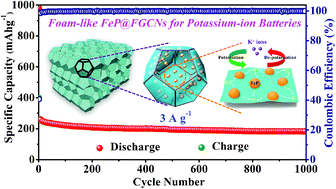The multi-yolk/shell structure of FeP@foam-like graphenic scaffolds: strong P–C bonds and electrolyte- and binder-optimization boost potassium storage†
Abstract
Low-cost potassium-ion batteries (KIBs) are emerging as an appealing technology for energy storage applications; however, the large radius of K+ brings great challenges during fast and durable potassium storage. Moreover, research on the electrolytes and binders used in KIBs is rarely reported. As a conversion-type anode material with high theoretical capacity, iron phosphide (FeP) is a promising candidate for service if its innate drawbacks of feeble electrical conductivity and inferior structural durability during cycling can be addressed. In this regard, we fabricated a three-dimensional (3D) foam-like graphenic carbon scaffold incorporated with FeP nanoparticles (FeP@FGCS) through a straightforward pyrolysis-blowing and phosphorization approach. The evenly incorporated FeP NPs were tightly fixed by strong P–C chemical bonds to the well-constructed FGCS scaffold, which not only served as a conductive pathway for accelerated transport of K+ and electron, but also alleviated the volume variation of FeP NPs accompanied with the K+ intercalation to preserve the integrity of the active materials. Moreover, the elaborately selected ether-based electrolyte and binder further facilitated the cycle stability of the electrodes. Thus, FeP@FGCS exhibited superior electrochemical activity in KIBs by maintaining the high specific capacity of 183 mA h g−1 after 1000 cycles at the high current density of 3 A g−1.

- This article is part of the themed collection: 2019 Journal of Materials Chemistry A HOT Papers


 Please wait while we load your content...
Please wait while we load your content...